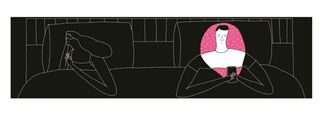10 secrets for creating an addictive app
With most of the population now glued to a tablet, laptop or smart phone, app development is still rising as one of the most prolific design prospects.

Take a look at our top ten secrets for developing your very own addictive app, provided by the forerunners of the app design world.
1. Design for the device
"Design from the 'inside-out' - that is, design for the device, embracing its potential and limitations - instead of designing 'idea-first' and then trying to make it work for the device," says Ge Wang, co-founder of California-based Smule.
"We strive to take advantage of how the iPhone differs from traditional desktop and laptop computers; to make apps that aren't simply 'mobile', but also truly unique experiences."
2. Draw on real life
"An application should be an intuitive, psychologically satisfying experience," insists developer Andrew Kaz. "First, open your mind and have a brainstorm.
Then define a clearly focused concept before writing a line of code or drawing a line of illustration. The best tricks for creating an addictive app completely depend upon the context - draw from comparable real-life objects and interactions. Consider what's familiar to your users and audience."
3. No one reads instructions
"Assume that the user doesn't read instructions and ensure the application is completely intuitive as far as understanding what does what in the user interface," advises Andrew Stein at PopCap Games.
"Handhold the user - in an engaging way - through the introduction of the various game elements. We put ourselves in the place of the end user and consider what somebody who has never looked at the app before might think about what's presented to them at every stage - that's the key."
4. Stay simple
"Keep things as simple as possible and build it up from there," says The Noble Union's Ryan Shelton.
"This will help you steer clear of designing anything that you don't need. Great apps are focused around a few key ideas. If there's a choice between complexity and simplicity, choose simplicity every single time."
5. Do one thing and do it well
"Good apps are generally single-purpose, functional things that help users out in their day-to-day lives," explains digital media director Russell Quinn.
"There are plenty of fun and quirky apps, but creating something that solves a common, daily problem is how you hook users. Start with the idea and not with the app."

6. Give incentives
"We always say that an app needs to do something more than a mobile website - something better and quicker, which enables the information to always be there in the palm of your hand.
Enable people to interact with others, and provide notifications of when users do something. Rewarding users' behaviour like this can prove very addictive, and pushing those rewards to social media can help take your app viral," says Apposing's Dave Brown.
7. Challenge convention
"Never re-purpose material," urges Ian Wharton at Zolmo. "For our Twenty Minute Meals app there was a balance of how much content can be digested efficiently in one go on the iPhone. It's not like a cookbook where you selectively scan a double-page spread.
For me, it was a real eye-opener into how a mobile platform can completely revolutionise something that's been done the same for years and years in print."
8. Find a hook
"The key is to find a unique angle, and market the app well. Apps like Fat Booth and Talking Carl have that viral effect where you show mates in the pub, while Angry Birds and Flick Kick Football are so goddamn addictive that you want to play them in any spare gaps you have in the day - on the bus, waiting for a meeting or on the loo," says Oli Christie at Neon Play.
9. Quality, stability, visibility
"Fast access is king, and that's why mobile apps are starting to replace websites as the first choice for information and fulfilment," advises Brandwidth's Dean Johnson.
"Quality, stability and visibility are fundamental - if your app has all three, then you're on the right track."
10. Be motivated
"There are all sorts of buttons that need pushing in app development, many of which don't even involve developing or designing: things like marketing, copyrighting, customer support, strategic planning - the list goes on," reflects Graham Clark at Glasshouse Apps.
"The one thing that you really need is a deep motivation to make a go of it. Without that, all the button-pushing can very easily get the better of you."
This feature was originally published in Computer Arts issue 191.
Liked this? Read these!
- The ultimate logo design guide
- Our favourite web fonts - and they don't cost a penny
- Useful and inspiring flyer templates
Are you in the middle of creating an addictive app? What are your favourite apps? Let us know in the comments box below!

Thank you for reading 5 articles this month* Join now for unlimited access
Enjoy your first month for just £1 / $1 / €1
*Read 5 free articles per month without a subscription

Join now for unlimited access
Try first month for just £1 / $1 / €1
Get the Creative Bloq Newsletter
Daily design news, reviews, how-tos and more, as picked by the editors.
The Creative Bloq team is made up of a group of design fans, and has changed and evolved since Creative Bloq began back in 2012. The current website team consists of eight full-time members of staff: Editor Georgia Coggan, Deputy Editor Rosie Hilder, Ecommerce Editor Beren Neale, Senior News Editor Daniel Piper, Editor, Digital Art and 3D Ian Dean, Tech Reviews Editor Erlingur Einarsson and Ecommerce Writer Beth Nicholls and Staff Writer Natalie Fear, as well as a roster of freelancers from around the world. The 3D World and ImagineFX magazine teams also pitch in, ensuring that content from 3D World and ImagineFX is represented on Creative Bloq.
